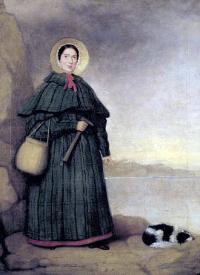
Mary Anning
Remember the old tongue twister, “She sells seashells by the seashore?” (Try saying that three times fast.) The tongue twisting seashell seller was inspired by a real woman named Mary Anning, an English fossil collector, dealer, and paleontologist, who did indeed sell seashells by the seashore, as well as accomplishing much, much more.
This month, it was announced that a set of stamps are being issued to recognize Mary Anning’s contribution to the modern understanding of dinosaurs.
Despite a lack of education and a life of poverty, Mary Anning became known as the “the greatest fossilist the world ever knew.” She is credited with the finding the first correctly identified ichthyosaur skeleton as well as the first nearly complete Plesiosaurus. She also found the first British Pterodactylus macronyx, a fossil flying reptile; the Squaloraja fossil fish, a transitional link between sharks and rays; and the Plesiosaurus macrocephalus.
Mary Anning was born in 1799 in the Dorset port town of Lyme Regis. Her father, Richard, was a cabinet maker by profession and a fossil hunter by avocation. He died at the age of 44 leaving the family destitute. Mary took up fossil hunting as a business to support her family. Lyme Regis was a resort town and fossils were often sold to wealthy visitors as curios. Mary Anning started her fossil business selling from a table on the beach.
The shale and sandstone cliffs of the Dorset Coast are rich in deposits laid down in the Triassic and Jurassic Periods. Anning searched for fossils in the area’s Blue Lias cliffs. It was arduous and dangerous work. She nearly died in a landslide in 1833.
In addition to collecting fossils, she read and studied all she could about fossils, paleontology, geology and biology. At the time the world of science was dominated by wealthy Anglican men. As a poor woman from a family of dissenters, Mary Anning was none of these. Nevertheless, over time, she earned the respect of the scientific community of her day. In 1838, she was awarded an annuity from the British Association for the Advancement of Science. The Geological Society of London presented her with a stipend and she was named the first Honorary Member of the new Dorset County Museum, one year before her death from breast cancer at the age of 47 in 1847. Her obituary was published in the Quarterly Journal of the Geological Society–an organization that would not admit women until 1904.
In 2012, an extinct genus of basal plesiosaur, Anningasaura lymense, was named in honor of Mary Anning of Lyme Regis.

You may not be aware of the book “Remarkable Creatures” by Tracy Chevalier which does an amazing job of bringing Ms. Anning to life. Strongly recommend.